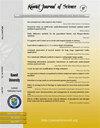Assessment of toxicity profile of Mollusca hemolymph: Insight into its potential biocompatibility and anti-biofilm efficacy
IF 1.1
4区 综合性期刊
Q3 MULTIDISCIPLINARY SCIENCES
引用次数: 0
Abstract
Traditional food habits followed by indigenous populations have a huge potential in providing nutrition to the world community aided with nutritional supplements. The phylum mollusca can provide alternative supplements for food and biochemical potentials. In the current investigation, the hemolymph of Pomacea canaliculata, Achatina fulica, and Lamellidense marginalis was collected through the heart puncture method and they were characterized through fourier transformation infrared spectroscopy (FTIR), gas chromatography-mass spectroscopy (GC-MS), Inductively coupled plasma atomic emission spectroscopy (ICP-OES), antioxidant activity, hemolysis, antimicrobial and antibiofilm activity. The collected hemolymph demonstrated a prominent 65 kDa protein band in Sodium Dodecyl Sulfate- Poly Acrylamide Gel Electrophoresis (SDS-PAGE). The hemolymph samples exhibited strong antioxidant activity against standard free radicals. They were found to be highly haemocompatible through hemolysis and hemagglutination assay. The hemolymph exhibited antimicrobial activity against the pathogenic Escherichia coli, Pseudomonas aeruginosa and Vibrio cholerae. All the test samples demonstrated high biofilm inhibiting activity through tube assay and Congo red assay. The hemolymph extracts confirmed dose dependent cell toxicity against the A431 skin carcinoma cells. Hence, this study provides an insight into the potential application of the hemolymph in various biomedical applications, which can be validated through future in vitro experimentations.
软体动物血淋巴毒性的评估:对其潜在生物相容性和抗生物膜功效的洞察
土著居民遵循的传统饮食习惯在向国际社会提供营养方面具有巨大的潜力。软体动物门可以为食物和生化潜能提供替代补充。本研究采用心脏穿刺法采集了小管Pomacea canaliculata、黄芩(Achatina fulica)和薄板草(Lamellidense marginalis)的血淋巴,并通过傅里叶变换红外光谱(FTIR)、气相色谱-质谱(GC-MS)、电感耦合等离子体原子发射光谱(ICP-OES)、抗氧化活性、溶血活性、抗菌活性和抗生物膜活性等方法对其进行了表征。经十二烷基硫酸钠-聚丙烯酰胺凝胶电泳(SDS-PAGE),发现血淋巴有一条明显的65 kDa蛋白带。血淋巴样品对标准自由基表现出较强的抗氧化活性。通过溶血和凝血试验,发现它们具有高度的血液相容性。血淋巴对致病性大肠杆菌、铜绿假单胞菌和霍乱弧菌具有抗菌活性。通过试管实验和刚果红实验,所有样品均显示出较高的生物膜抑制活性。血淋巴提取物对A431皮肤癌细胞具有剂量依赖性的细胞毒性。因此,本研究为血淋巴在各种生物医学应用中的潜在应用提供了新的思路,可以通过未来的体外实验进行验证。
本文章由计算机程序翻译,如有差异,请以英文原文为准。
求助全文
约1分钟内获得全文
求助全文
来源期刊

Kuwait Journal of Science
MULTIDISCIPLINARY SCIENCES-
CiteScore
1.60
自引率
28.60%
发文量
132
期刊介绍:
Kuwait Journal of Science (KJS) is indexed and abstracted by major publishing houses such as Chemical Abstract, Science Citation Index, Current contents, Mathematics Abstract, Micribiological Abstracts etc. KJS publishes peer-review articles in various fields of Science including Mathematics, Computer Science, Physics, Statistics, Biology, Chemistry and Earth & Environmental Sciences. In addition, it also aims to bring the results of scientific research carried out under a variety of intellectual traditions and organizations to the attention of specialized scholarly readership. As such, the publisher expects the submission of original manuscripts which contain analysis and solutions about important theoretical, empirical and normative issues.
 求助内容:
求助内容: 应助结果提醒方式:
应助结果提醒方式:


